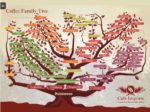When I smell dark roast coffees in a coffee store, they always smell bold and intense. Why doesn’t my lighter roast coffee have much of an aroma?
Ah the perennial question! Some think that lighter roast coffee cannot be too ‘intense’ or ‘bold’ in the cup if there isn’t a giant cloud of luscious coffee aroma when they open the container. There is a reasonable explanation: It has to do with where the flavor components are, especially those residing the in the oils inside the bean. Let me explain.
When a coffee bean is roasted, chemical changes take place as heat is applied. Oils are driven closer to the surface, and as they reach the magic point where the Malliard reaction takes place, the oil is oxidized and driven to the surface. That’s why espresso roasts are all dark and oily and why dark roast beans go stale quickly. In general the Malliard reaction is the watershed event in roasting that marks a difference between a) coffee material that is only partially oxidized and retains some of its sugars and origin characteristics and b) the point where the plant matrix and most of the sugars are now carbonized. The oils no longer are in the matrix but on the surface. The flavors are now carbon bittering with whatever partially-oxidized flavor is retained in the oils. Some like this bittering, but it can be spoiled by exposure to air. Stale coffee is bad coffee.
There really is a great deal of chemistry involved. Suffice it to say that Dark Roast carries all its actual coffee flavors in the oils on the surface. Beans that are less than dark roasted still have all the original sugars and oils, and they are inside the bean. They won’t smell as intense initially because they are ‘hiding’ their goodness inside. You have to grind and brew to release their flavors. Be aware that lighter roasts won’t smell as intense initially. They will grow in intensity when you grind them and reach full strength when you pour it in the cup.


